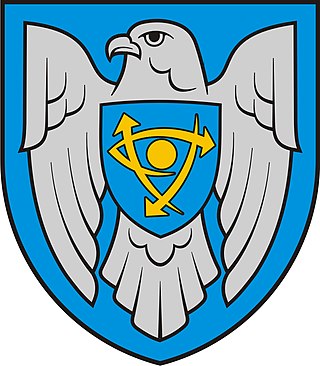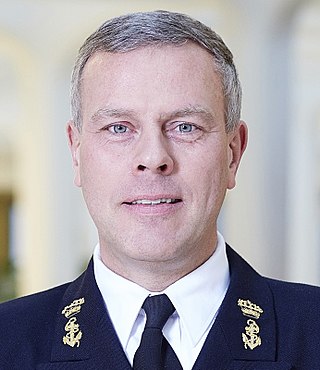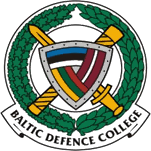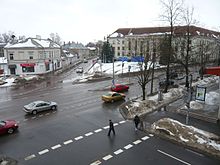
Latvia, officially the Republic of Latvia, is a country in the Baltic region of Northern Europe. It is one of the three Baltic states, along with Estonia to the north and Lithuania to the south. It borders Russia to the east, Belarus to the southeast, and shares a maritime border with Sweden to the west. Latvia covers an area of 64,589 km2 (24,938 sq mi), with a population of 1.9 million. The country has a temperate seasonal climate. Its capital and largest city is Riga. Latvians belong to the ethnolinguistic group of the Balts and speak Latvian, one of the only two surviving Baltic languages. Russians are the most prominent minority in the country, at almost a quarter of the population.

The Lithuanian Armed Forces are the military of Lithuania. The Lithuanian Armed Forces consist of the Lithuanian Land Forces, the Lithuanian Naval Force, the Lithuanian Air Force and the Lithuanian Special Force. In wartime, the Lithuanian State Border Guard Service becomes part of the Lithuanian Armed Forces. A special security department handles VIP protection and communications security.

The Baltic states or the Baltic countries is a geopolitical term encompassing Estonia, Latvia, and Lithuania. All three countries are members of NATO, the European Union, the Eurozone, and the OECD. The three sovereign states on the eastern coast of the Baltic Sea are sometimes referred to as the "Baltic nations", less often and in historical circumstances also as the "Baltic republics", the "Baltic lands", or simply the Baltics.

The Baltic air-policing mission is a NATO air defence Quick Reaction Alert (QRA) in order to guard the airspace above the three Baltic countries of Estonia, Latvia and Lithuania.

The Lithuanian Air Force or LAF is the military aviation branch of the Lithuanian armed forces. It is formed from professional military servicemen and non-military personnel. Units are located at Zokniai Air Base near the city Šiauliai, at Radviliškis and Kaunas.

The Estonian Air Force is the aviation branch of the Estonian Defence Forces. The air force traces its history to 1918, and was re-established in its current form in 1991.
Beginning on 27 April 2007, a series of cyberattacks targeted websites of Estonian organizations, including Estonian parliament, banks, ministries, newspapers and broadcasters, amid the country's disagreement with Russia about the relocation of the Bronze Soldier of Tallinn, an elaborate Soviet-era grave marker, as well as war graves in Tallinn. Most of the attacks that had any influence on the general public were distributed denial of service type attacks ranging from single individuals using various methods like ping floods to expensive rentals of botnets usually used for spam distribution. Spamming of bigger news portals commentaries and defacements including that of the Estonian Reform Party website also occurred. Research has also shown that large conflicts took place to edit the English-language version of the Bronze Soldier's Wikipedia page.

The Allied Air Command (AIRCOM) is the central command of all NATO air and space forces and the Commander Allied Air Command is the prime air and space advisor to the Alliance. When directed by the Supreme Allied Commander Europe (SACEUR), it provides the core of the headquarters responsible for the conduct of air operations. The command is based at the Ramstein Air Base in Germany.

NATO is an international military alliance consisting of 31 member states from Europe and North America. It was established at the signing of the North Atlantic Treaty on 4 April 1949. Article 5 of the treaty states that if an armed attack occurs against one of the member states, it shall be considered an attack against all members, and other members shall assist the attacked member, with armed forces if necessary. Article 6 of the treaty limits the scope of Article 5 to the islands north of the Tropic of Cancer, the North American and European mainlands, the entirety of Turkey, and French Algeria, the last of which is moot. Thus, an attack on Hawaii, Puerto Rico, French Guiana, the Falkland Islands, Ceuta or Melilla, among other places, would not trigger an Article 5 response.

The Estonian Defence Forces is the unified military force of the Republic of Estonia. The Estonian Defence Forces consists of the Estonian Land Forces, the Estonian Navy, the Estonian Air Force, and the paramilitary Estonian Defence League. The national defence policy aims to guarantee the preservation of the independence and sovereignty of the state, the integrity of its land area, territorial waters, airspace and its constitutional order. Its main goals remain the development and maintenance of a credible capability to defend the nation's vital interests and development of the defence forces in a way that ensures their interoperability with the armed forces of NATO and European Union member states to participate in the full range of missions for these military alliances.

NATO CCD COE, officially the NATO Cooperative Cyber Defence Centre of Excellence, is one of NATO Centres of Excellence, located in Tallinn, Estonia. The centre was established on 14 May 2008, it received full accreditation by NATO and attained the status of International Military Organisation on 28 October 2008. NATO Cooperative Cyber Defence Centre of Excellence is an international military organisation with a mission to enhance the capability, cooperation and information sharing among NATO, its member nations and partners in cyber defence by virtue of education, research and development, lessons learned and consultation.

The Airspace Surveillance and Control Command is a branch of the Lithuanian Air Force responsible for surveillance and control the airspace of Lithuania. While implementing resolutions of the Parliament of the Republic of Lithuania concerning Principal Structure of the Lithuanian Armed Forces and Armed Forces’ development plans, the Lithuanian military have expanded and increased defence capabilities. Therefore, the Air Surveillance and Control Command has also evolved. Presently, five radar posts have been established to monitor Lithuanian air space. The command cooperates with governmental enterprise "Air Navigation", Governmental Board Security Service and other institution.

Lithuanian–Polish–Ukrainian Brigade "TLATAS" is a multinational brigade countries of the Lublin Triangle consisting of units from the Lithuanian, Polish and Ukrainian armies. Other countries are free to join the trilateral agreement. An agreement on its creation was signed on November 16, 2009. The brigade was to reach operational status in autumn 2011, but it was delayed; a January 2012 estimate put that date at some time in 2013. The unit was finally formed on September 19, 2014. In July 2015 the defense ministers of the three countries signed an agreement on the operation of the unit.

Estonia, officially the Republic of Estonia, is a country by the Baltic Sea in Northern Europe. It is bordered to the north by the Gulf of Finland across from Finland, to the west by the sea across from Sweden, to the south by Latvia, and to the east by Lake Peipus and Russia. The territory of Estonia consists of the mainland, the larger islands of Saaremaa and Hiiumaa, and over 2,200 other islands and islets on the eastern coast of the Baltic Sea, covering a total area of 45,339 square kilometres (17,505 sq mi). The capital city Tallinn and Tartu are the two largest urban areas of the country. The Estonian language is the indigenous and the official language of Estonia; it is the first language of the majority of its population, as well as the world's second most spoken Finnic language.

WEST 2017 was a joint strategic military exercise of the armed forces of the Russian Federation and Belarus that formally began on 14 September 2017 and ended on 20 September 2017, in Belarus as well as in Russia's Kaliningrad Oblast and Russia's other north-western areas in the Western Military District. According to the information made public by the Defence Ministry of Belarus prior to the exercise, fewer than 13,000 personnel of the Union State were to take part in the military maneuvers, a number that was not supposed to trigger mandatory formal notification and invitation of observers under the OSCE's Vienna Document.

Robert Peter Bauer is a Dutch lieutenant admiral in the Royal Netherlands Navy, currently serving as the Chair of the NATO Military Committee since June 2021, after succeding Air Chief Marshal Stuart Peach. Bauer previously served as the Chief of Defence from October 2017 to April 2021, and as the Vice Chief of Defence of the Armed forces of the Netherlands from 1 September 2015 to 13 July 2017. Bauer was also involved in anti-terrorist and anti-piracy operations in the Mediterranean Sea, the and in the Horn of Africa.

The history of the North Atlantic Treaty Organization (NATO) begins in the immediate aftermath of World War II when British diplomacy set the stage to contain the Soviet Union and to stop the expansion of Soviet power in Europe. The United Kingdom and France signed, in 1947, the Treaty of Dunkirk, a defensive pact, which was expanded in 1948 with the Treaty of Brussels to add the three Benelux countries and committed them to collective defense against an armed attack for fifty years. The British worked with Washington to expand the alliance into NATO in 1949, adding the United States and Canada as well as Italy, Portugal, Norway, Denmark, and Iceland. Greece and Turkey joined in 1952, West Germany joined in 1955, Spain joined in 1982, Czech Republic, Hungary and Poland joined in 1999, Bulgaria, Estonia, Latvia, Lithuania, Romania, Slovakia, and Slovenia joined in 2004, Albania and Croatia joined in 2009, Montenegro joined in 2017, North Macedonia joined in 2020, and Finland joined in 2023.


The Intermarium region comprises a group of geographically contiguous Central and Eastern European countries that share a common historical, social, and cultural identity. Many were socialist buffer republics, either Soviet republics or otherwise subordinate to the USSR. As a region, they form a land buffer from the Baltic to the Black Sea that could balance future Russian influence in Europe.




















